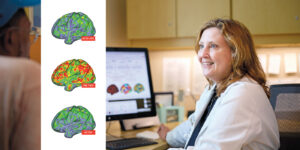Linde Jacobs paced back and forth across her bedroom, eyeing the open laptop on the dresser and willing the doctor to appear. Her husband was dropping off their older daughter at school. Their younger daughter was downstairs, occupied by a screen. Linde wanted to be alone when she learned whether she carried the family curse.
Fighting to Avoid Her Mother’s Fate, for Her Daughters’ Sake









